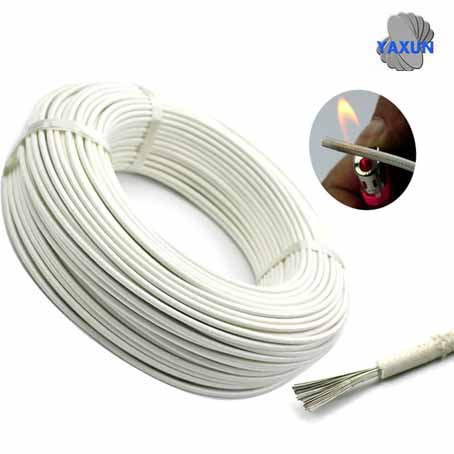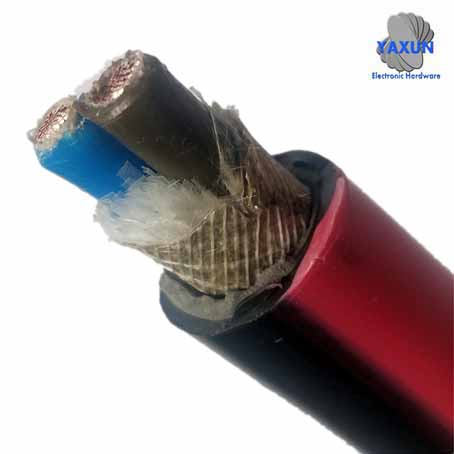Fire-Resistant Cable Selection and Manufacturing
What is a fire-resistant (YTTW) cable?
The fire-resistant (YTTW) cable refers to a cable that can operate safely in the case of flame combustion. The fire-resistant cable is widely used in high-rise buildings, underground railways, underground streets, large power stations and important industrial and mining enterprises. For example: power supply and control lines for fire protection equipment, emergency equipment. Fire-resistant power cables are manufactured by EC502-1983, and fire resistance characteristics are in line with IEC331-1970 specified 120 mm2.
Application conditions
1. AC rated voltage: U./U (V series: 600/1000V, K series: 450/750V, B series: 450/750V).2. The highest long-term working temperature of the cable
(1) Insulating sheath of polyvinyl fluoride: 70℃ and 105℃; Insulation of XLPE: 90℃;
(2) Insulation sheath of fluoroplastics: 220℃ and 260℃; Fluoroplastic insulation and 105°C flame-retardant polyvinyl fluoride sheath: 90°C and 125°C.
(3) Low-halogen, low-smoke, flame-retardant PVC insulation sheath: 70℃; Halogen-free and low-smoke flame-retardant polyolefin insulation jacket: 90℃ and 125℃.
3. The lowest ambient temperature:
(1) Flame-retardant PVC insulation sheath: fixed laying -40℃; Non-fixed laying -15℃;
(2) Fluoroplastic insulation sheath: fixed laying -60℃; Non-fixed laying-20℃;
4. The safe laying temperature of cables should not be lower than 0℃.
5. Fire resistance characteristics:
Comply with GA 306.2-2007, GB/T 19216.21-2003 regulations
| Flame temperature | Flame temperature 950℃-1000℃ | Flame temperature 750℃-800℃ |
| Burning time | Burning time 90min (recommended) | Burning time 90min (recommended) |
| Additional voltage | Rated voltage (minimum 100V) | Rated voltage (minimum 100V) |
| Fire resistance level | Class A (Class IA~Class IVA) | Class I~IV |
6. The recommended allowable bending radius for laying:
Unarmored, braided shielded cables should not be less than 6 times the outer diameter of the cable;
The steel tape armored cable should not be less than 12 times the outer diameter of the cable;
The cable of fluoroplastic insulation and sheath material should not be less than 8 times the outer diameter of the cable
Common model
| model | Name | Remark |
| NA-YJV/NB-YJV | XLPE insulated PVC sheathed Class A (B) fire-resistant power cable | It can be installed indoors, tunnels and pipelines that require fire resistance. |
| NA-YJV22/NB-YJV22 | XLPE insulated steel tape armored PVC sheathed Class A (B) fire-resistant power cable | It is suitable for laying in the ground when fire resistance is required, but not suitable for laying in pipelines. |
| WDNA-YJY/WDNB-YJY | XLPE insulated polyolefin sheathed A (B) halogen-free low-smoke fire-resistant power cable | It can be installed in indoors, tunnels and pipelines that require halogen-free, low-smoke and fire resistance. |
| WDNA-YJY23/WDNB-YJY23 | XLPE insulated steel tape armored polyolefin sheathed type A (B) halogen-free low-smoke fire-resistant power cable | It is suitable for laying in the ground when halogen-free, low-smoke and fire resistance are required, but not suitable for laying in pipelines. |
Model meaning
1. Model compositionThe model of flame-retardant and fire-resistant wire and cable is composed of two parts: the product combustion characteristic code and the related model, as shown in the figure
2. Code table of combustion characteristics
| Codename | name |
| Za | Flame retardant |
| ZA | Flame Retardant Class A |
| ZB | Flame Retardant Class B |
| ZC | Flame Retardant Class C |
| ZDb | Flame Retardant Class D |
| Omit | Halogenated |
| W | Halogen free |
| D | Low smoke |
| U | Low toxicity |
| N | refractory |
| NJ | Fire-resistant plus impact |
| NS | Refractory and water spray |
|
a, Z is the flame retardant of a single wire, which is only used for products whose base material does not contain halogen. If the base material contains halogen, Z is omitted. b. ZD is a class D of bundle combustion, which is suitable for products with an outer diameter of no more than 12mm, that is, finer products. |

Classification
Ordinary fire-resistant cables are divided into Type A and Type B: Class B cables can withstand combustion for at least 90 minutes in a flame of 750℃~800℃ and rated voltage without the cable being broken down (that is, the 3A fuse will not blow). On the basis of improving the manufacturing process of the refractory layer and adding the refractory layer and other methods, the Class A refractory cable has been developed. It can withstand combustion for at least 90 minutes in a flame of 950℃~1 000℃ and rated voltage without the cable being broken down (that is, the 3A fuse will not blow). The fire resistance of Class A fire-resistant cable is better than that of Class B. In addition, mineral insulated cables are one of the best performance among fire-resistant cables. It is made of copper core, copper sheath, and magnesium oxide insulating materials, called MI (minerl insulated cables) for short. The cable is entirely composed of inorganic substances as the refractory layer, while the refractory layer of the ordinary refractory cable is composed of inorganic substances and general organic substances. Therefore, the fire resistance of MI cable is better than that of ordinary fire-resistant cable and will not decompose and generate corrosive gas due to combustion. MI cable has good fire resistance characteristics and can work at a high temperature of 250 ℃ for a long time. At the same time, it has the characteristics of explosion-proof, strong corrosion resistance, large current-carrying capacity, radiation resistance, high mechanical strength, small size, light weight, long life and no smoke. However, the price is expensive, the process is complicated, and the construction is difficult. This kind of cable with good fire resistance can be used in oil irrigation areas, public buildings with important wooden structures, high temperature places and other occasions with high fire resistance requirements and acceptable economic efficiency.Choose
According to the specific characteristics of fire-resistant cables, designers should pay attention to the following issues when designing and selecting:(1) When fire-resistant cables are used in cable tunnels, cable interlayers with dense cables, or in flammable places such as oil pipes, oil depots, etc., Class A fire-resistant cables should be selected first. In addition to the above cases and when the number of cables is small, Class B fire-resistant cables can be used.
(2) Fire-resistant cables are mostly used as power supply circuits for emergency power supplies and require normal operation in case of fire. As the ambient temperature rises sharply during a fire, in order to ensure the transmission capacity of the line, the pressure drop is reduced. For circuits with long power supply lines and strictly limited allowable voltage drops, the cross-section of the fire-resistant cable should be enlarged by at least one level.
(3) Fire-resistant cables cannot be used as high-temperature cables.
(4) In order to reduce the failure rate of cable joints in fire accidents, the number of joints should be reduced as much as possible during installation to ensure that the line can work normally in a fire. If branch wiring is needed, fire-proof the joints should be done.





